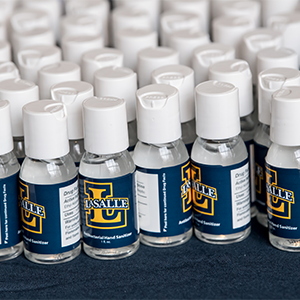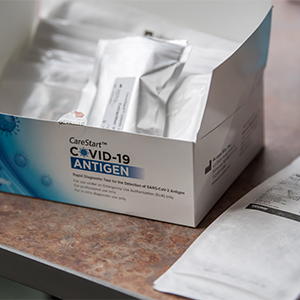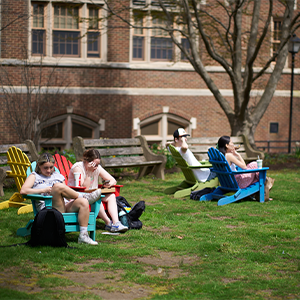The University delivered an in-person learning and on-campus student experience, with a low positivity rate, as COVID-19 cases soared nationally.
At the Omicron variant’s peak, COVID-19 case counts in the United States rocketed to record-high figures around the holiday season and for most of the winter.
Still, La Salle University maintained a campus positivity rate of less than 3% among those who tested on campus, with zero interruption to in-person classes and on-campus learning during the spring semester. In fact, all but four days of the 2021-22 academic year (at the start of the fall term) were delivered in a classroom setting.
Case counts on campus remained low—even after the University followed city health department guidance and removed a campus mask requirement. La Salle returned to hosting full-capacity sporting events, and large-scale festivities and smaller events. The campus experience closely resembled what it had in 2020, prior to the pandemic.
“Our student organizations and clubs, for nearly two years, had found creative ways to stay connected and engage regularly with one another—whether through Zoom or in small socially distanced gatherings,” said Gabrielle St. Léger, Ed.D, Vice President of Student Development & Campus Life. “It was rewarding for our students to get back to a campus experience that our Explorers have craved.”
How was all this possible?
It’s the result of campus-wide adherence to the University’s health and safety guidelines, said La Salle’s Assistant Vice President of Student Wellness R. Scott Cook, D.O. Cook pointed to universal cooperation with safety protocols and a “selfless commitment” from all.
“Our ability to deliver on-campus and in-person learning, both effectively and safely, is due to our community’s selfless commitment to responsible activity,” said Cook, who also serves as a member of the University’s COVID-19 response team. “Our students, faculty, and staff complied with masking guidelines. They knew to stay home when they were feeling less than 100% and made alternative plans with their instructors and supervisors. They knew they could visit our campus testing center for a free test whenever necessary. These steps helped us stay in the classroom and return fully to the in-person experience we all prefer.”
The following numerical figures, as of May 3, provide a glimpse into how La Salle kept its campus community safe throughout the academic year:
Personal protective equipment (PPE)
11,000+: Surgical masks distributed
4,555: 1 oz. bottles of hand sanitizer dispersed
3,973: La Salle-branded cloth masks distributed
2,800+: N95 and KN95 respirators handed out
500+: Number of hand sanitizer stations installed on campus
32: Gallons of hand sanitizer used in dispensers throughout campus buildings
Testing
12,287: Number of rapid antigen tests administered at La Salle*
<3%: Observed positivity rate on all tests administered on campus in Spring 2022
850+: Hours staffed at the University’s testing center
800+: Student practicum hours accrued at the testing center
60: Hours of student volunteer time logged at the testing center
31: Contact tracers trained and utilized by La Salle
Vaccines and boosters
95.1%: Percentage of campus community that has received its primary COVID-19 vaccine series
74%: Percentage of campus community that had received a COVID-19 booster
1,606: Total doses of the COVID-19 vaccine administered through multiple on-campus vaccine clinics*
* —from 1/1/2021–5/20/2022
—Christopher A. Vito